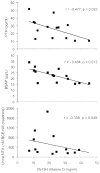Bone health in young women with epilepsy after one year of antiepileptic drug monotherapy
- PMID: 18443309
- PMCID: PMC3139539
- DOI: 10.1212/01.wnl.0000310981.44676.de
Bone health in young women with epilepsy after one year of antiepileptic drug monotherapy
Abstract
Objective: Antiepileptic drugs (AEDs) may have adverse effects on bone mineral density (BMD) and metabolism. We previously reported biochemical evidence of increased bone turnover in premenopausal women with epilepsy on phenytoin monotherapy compared with those on carbamazepine, lamotrigine, and valproate. We therefore hypothesized that rates of bone loss would be higher in young women treated with phenytoin.
Methods: Ninety-three premenopausal women with epilepsy receiving a single AED (carbamazepine, lamotrigine, phenytoin, or valproate) participated. Subjects completed nutritional and physical activity questionnaires. Biochemical indices of bone and mineral metabolism and BMD of the proximal femur and lumbar spine were measured at baseline and 1 year.
Results: Participants reported high calcium intake (>1,000 mg/day) and were physically active. Significant loss (2.6%) was seen at the femoral neck in the phenytoin group. BMD remained stable in the other AED groups. Bone turnover markers and calciotropic hormones were unchanged after 1 year in all groups except for a significant decline in urine N-telopeptide in the phenytoin group. In women receiving phenytoin, lower serum 25-hydroxyvitamin D concentrations were associated with higher parathyroid hormone, bone alkaline phosphatase, and urine N-telopeptide levels, a biochemical pattern consistent with secondary hyperparathyroidism and increased remodeling.
Conclusion: In this study, young women treated with phenytoin had significant femoral neck bone loss over 1 year. In contrast, those treated with carbamazepine, lamotrigine, and valproate did not have detectable adverse effects on bone turnover or bone mineral density. These results raise concerns about the long-term effects of phenytoin monotherapy on bone in young women with epilepsy.
Figures


Comment in
-
Bone health.Neurology. 2008 Apr 29;70(18):e71-3. doi: 10.1212/01.wnl.0000313935.44801.3b. Neurology. 2008. PMID: 18443305 No abstract available.
-
Screening bone mineral density in epilepsy: a call to action, but what action?Epilepsy Curr. 2009 Mar-Apr;9(2):44-6. doi: 10.1111/j.1535-7511.2008.01288.x. Epilepsy Curr. 2009. PMID: 19421379 Free PMC article. No abstract available.
Similar articles
-
Bone mass and turnover in women with epilepsy on antiepileptic drug monotherapy.Ann Neurol. 2005 Feb;57(2):252-7. doi: 10.1002/ana.20378. Ann Neurol. 2005. PMID: 15668966 Free PMC article.
-
The effect of topiramate monotherapy on bone mineral density and markers of bone and mineral metabolism in premenopausal women with epilepsy.Epilepsia. 2011 Oct;52(10):1884-9. doi: 10.1111/j.1528-1167.2011.03131.x. Epub 2011 Jun 21. Epilepsia. 2011. PMID: 21692779 Clinical Trial.
-
A 6-month longitudinal study of bone mineral density with antiepileptic drug monotherapy.Epilepsy Behav. 2007 Mar;10(2):291-5. doi: 10.1016/j.yebeh.2006.11.007. Epub 2007 Jan 16. Epilepsy Behav. 2007. PMID: 17224308
-
Monostars: an aid to choosing an antiepileptic drug as monotherapy.Epilepsia. 1999;40 Suppl 6:S17-22; discussion S73-4. doi: 10.1111/j.1528-1157.1999.tb00928.x. Epilepsia. 1999. PMID: 10530678 Review.
-
Epilepsy and bone health in adults.Epilepsy Behav. 2004 Feb;5 Suppl 2:S24-9. doi: 10.1016/j.yebeh.2003.11.029. Epilepsy Behav. 2004. PMID: 15123008 Review.
Cited by
-
Bone health in pediatric patients with neurological disorders.Ann Pediatr Endocrinol Metab. 2020 Mar;25(1):15-23. doi: 10.6065/apem.2020.25.1.15. Epub 2020 Mar 31. Ann Pediatr Endocrinol Metab. 2020. PMID: 32252212 Free PMC article.
-
Bone microarchitecture in adolescent boys with autism spectrum disorder.Bone. 2017 Apr;97:139-146. doi: 10.1016/j.bone.2017.01.009. Epub 2017 Jan 11. Bone. 2017. PMID: 28088646 Free PMC article.
-
A Prospective Longitudinal Study of the Effects of Eslicarbazepine Acetate Treatment on Bone Density and Metabolism in Patients with Focal-Onset Epilepsy.CNS Drugs. 2023 Nov;37(11):973-980. doi: 10.1007/s40263-023-01045-0. Epub 2023 Nov 3. CNS Drugs. 2023. PMID: 37921919 Free PMC article.
-
Bone turnover markers in epileptic patients under chronic valproate therapy.J Res Med Sci. 2013 Apr;18(4):338-40. J Res Med Sci. 2013. PMID: 24124434 Free PMC article.
-
Medication-induced osteoporosis: screening and treatment strategies.Ther Adv Musculoskelet Dis. 2014 Oct;6(5):185-202. doi: 10.1177/1759720X14546350. Ther Adv Musculoskelet Dis. 2014. PMID: 25342997 Free PMC article. Review.
References
-
- Souverein PC, Webb DJ, Petri H, Weil J, Van Staa TP, Egberts T. Incidence of fractures among epilepsy patients: a population-based retrospective cohort study in the General Practice Research Database. Epilepsia. 2005;46:304–310. - PubMed
-
- Verrotti A, Greco R, Morgese G, Chiarelli F. Increased turnover in epileptic patients treated with carbamazepine. Epilepsia. 2000;47:353–358. - PubMed
-
- Verrotti A, Greco R, Latini G, Morgese G, Chiarelli F. Increased bone turnover in prepubertal, pubertal, and postpubertal patients receiving carbamazepine. Epilepsia. 2002;43:1488–1492. - PubMed
-
- Tekgul H, Dizdarer G, Demir N, Ozturk C, Tutuncuoglu S. Bone mineral status in pediatric outpatients on antiepileptic drug monotherapy. J Child Neurol. 2004;19:26–30. - PubMed
-
- Wu S, Legido A, DeLuca F. Effects of valproic acid on longitudinal bone growth. J Child Neurol. 2004;19:26–30. - PubMed
